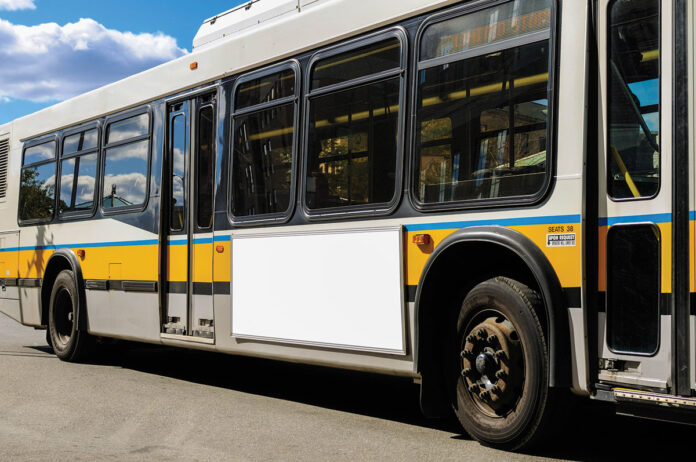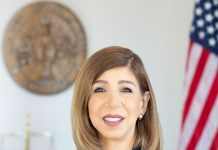San Diego 350, so named for the number that leading scientists say is the safe upper limit for carbon dioxide, is a volunteer organization building a movement to prevent the worst impacts of climate change and climate injustice through education, outreach, public policy advocacy, and direct action efforts.
In action, that looks like San Diego 350 volunteers like Savanna O’Toole speaking at a recent San Diego Association of Governments meeting where the agency announced plans to improve public transportation options between 2021 and 2050.
“We would like environmental justice to be embedded in San Diego,” O’Toole said, and called for changes including increased bussing on overcrowded lines, 24-hour trolley service “to connect late night to early morning workers to their jobs,” options for residents in underserved communities, no-cost transit plans for all riders 24 and younger to ensure generations of transit riders, an electrified bus fleet by 2030, and open bathrooms at all major transit stations.
San Diego 350 Public Policy Committee Chair Marie Chen, who oversees about 135 members across several subcommittees, said three of the largest teams are Transportation, Climate and Renewable Action, and the State Legislation Team.
Improving public transportation can be tough, she said, as microregions can include underserved communities as well as some that are very spread out.
“It’s difficult to make public transportation convenient for everyone. Our transportation team works a lot with SANDAG, looking at mobility hubs and trying to centralize the first mile-last mile approach, getting people from their origin to mass transit. Mass transit all over the place isn’t practical but maybe we can get people from their homes to mass transportation,” Chen said.
In addition to mobilizing for transportation, San Diego 350 also has many volunteers working on the Climate Action and Renewable Energy committees, she said, a huge team that works with jurisdictions throughout San Diego County to improve their climate action plans and items like accountability and how to correctly measure baselines.“We also encourage cities to declare climate emergency declarations because it gives cities more robust capabilities to react with greater urgency,” Chen said.
There is a relationship between social and environmental justice, Chen said but she views it as the same fight in different areas, with change dependent on dialogue to better understand people’s perspectives.
“We cannot just bring the more financially comfortable people into the climate battle- those people have the money to buy their own solar, their own batteries but as a software engineer, my mind works in data and when you look at the numbers, from a purely pragmatic point of view, we have to bring everyone along or we’re not going to be successful,” Chen said.
It is important, she said, to “talk outside the bubble” to those who don’t think climate change is important. Talking in terms of numbers, rather than social justice terms opens up the conversation with a different cohort.
Just as she supports reaching different demographics, she believes the organization succeeds when it applies different approaches to the same goal, with direct action efforts like public rallies and local outreach complementary to the policy work being done with local legislators.
She made an example of their recent push for a more equitable franchise agreement with fossil-fuel company Sempra, which owns San Diego Gas and Electric.
“We did not come out entirely successful, although the agreements are better than they were. Just looking at the approach, however, we did a direct action campaign with protests and rallies outside Sempra while others were talking to city council members, staff, writing letters. You have to approach policy as a multi-prong solution,” Chen said.
Their State Legislation team does a good deal of training, she said, gathering people who likely have never been to a lobbying meeting and picking top priorities before meeting with “as many of our local state legislators” as possible.
“We try to train our members on how to speak at council meetings, state commission meetings, constantly trying to upscale our members so they can be better advocates, develop relationships with certain offices,” Chen said, as it works well to have youth in any meeting with elected officials.
“Traditionally, most volunteer organizations are older people and we do have a strong core of people who are die-hard and it’s inspiring to watch them work. However, we are definitely attracting more younger people, Millennials, recent grads… There’s been a lot of talk about working intergenerationally,” Chen said.
The same series of microregional SANDAG meetings where O’Toole called for more public transportation in the East County region also yielded similar commentary from South County with resident Carolina Martinez asking planners to consider reducing the cost of trolley transportation for youth now, “not ten years from now” so they can connect to better paying jobs.
However, that same meeting also had National City resident Rosina Lizaroga call in and say some seniors she works with struggle with mobility problems and feel safest in their own vehicle, illustrating that an underserved population in El Cajon might need different solutions than one in National City.
“One thing that’s true of all environmental organizations is that we need to reach out to communities we’re worried about and get their voices involved because nothing is worse than a bunch of privileged people coming in and saying what someone needs in their lives and how to do it right. That’s not a good look,” Chen said.
She said the organization considers it a welcome challenge to find local organizations and get out into their neighborhoods, work alongside them.
“You have to have pure conviction but be rooted in reality. You’re not going to win everything but you can always make progress,” Chen said, citing a Barack Obama quote: “Better is good”.















